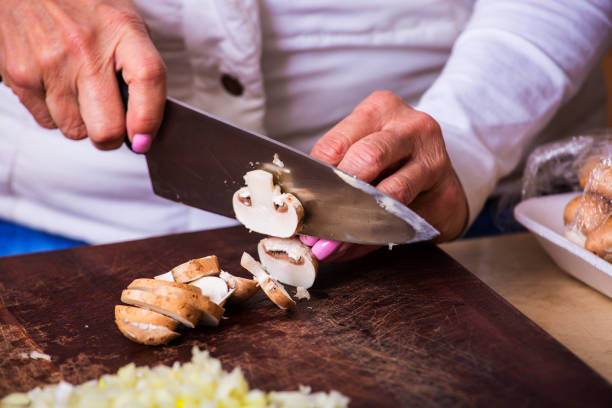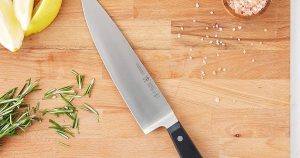
WHAT KIND OF KNIVES DO CHEFS USE?
Believe me, even if Gordon Ramsay himself cuts a meat steak with a blunt knife, he will not get even slices for a juicy steak. A low-quality knife cuts equally badly in the rivers of a restaurant chef and an inexperienced cook. The difference is that the eminent chef highly appreciates the quality of the tool he works with, and in his arsenal, there are always only professional and ultra-sharp blades. Let’s talk about what kind of knives chefs use and what they are guided by when choosing.
WHAT KNIVES DOES A CHEF NEED FIRST?
A professional knife experiences much greater stress than a regular kitchen knife, so it must be durable and wear-resistant. High performance and premium materials come at a price, of course, so professional knives can’t be cheap.
The set of tools for a serious kitchen invariably includes blades from the “chef’s trio”. These are basic knives for the main types of work. Here are the models they are:
visit us: Damascus Handmade Chef Knife
Chef or cook.
The most massive and largest specimen. It has a straight cutting edge, pointed tip, thick butt, and base. With it, you can cut, cut, clean a variety of categories of products. But the target is still considered meat, fish, root crops, vegetables, and fruits. The technique of work can be both classical “pendulum” and chopping. This blade is considered to be the “calling card” of the cook, it is selected individually, depending on the convenience of the location in the hand, length, weight, size, and material of the handle. With this knife, the chef works more often and more intensively than with other varieties. Of course, the high quality of the blade material and its impeccable sharpness and hardness come to the fore.
Serrated knife or serrated knife.
If in the home kitchen you can generally do without such an instance, then for the chef it is indispensable. Only with such a blade will it be possible to carefully cut soft bread, make slices of tomatoes and other products with a dense skin and juicy pulp. Thanks to the wavy cutting edge, the serrator does not cut, but delicately cuts the product, maintaining its integrity, without crushing.
Vegetable.
This is a small blade that is useful for finely peeling, coring, cutting wormholes and small fruits and vegetables. With its help, the cook will be able to make decorative figures cutting off slices.
WHAT KNIVES DO CHEFS USE BESIDES THE BASIC ONES?
Of course, the arsenal of a professional chef is not limited to copies of the “cook” trio. Other models are used less often, but they have no equal in solving certain problems. Highly specialized blades are designed to work with certain categories of products or provide for a special cutting technique. What is included in the set depends on the specialization of the chef and the types of dishes he prepares.
We list the most popular models:
Steak.
Knife with a straight, serrated, or combined cutting edge, used for cutting portioned pieces of cooked meat.
boning.
Necessary for separating meat from bones, trimming. It has a long, narrow blade with moderate flexibility, making the blade easily go around the bones.
Hatchet.
Designed for cutting medium and small bones when butchering poultry, fragments of pork carcasses, beef, lamb, large fish.
Santoku.
The Japanese equivalent of a chef knife, but lighter in weight and more compact in size. The tip is lowered down, so it is convenient to work in the technique of chopping movements – “up and down”.
Slicer.
It is intended for thin cutting of cheese, sausages, delicacies, vegetables.
It is worth considering that professional chefs have excellent cutting techniques, so they often choose Japanese tools with one-sided sharpening. Such blades are sharpened at a minimum angle – right-handed or left-handed. The contact area of the cutting edge with the product, in this case, is minimal, which means that the cut is perfectly even, and cutting requires almost no effort.
However, many chefs are also faithful to European-style knives with classic double-edged sharpening. However, such blades are also preferred by Japanese brands or from Japanese steel, because it is in this country that the best professional knives and steel grades are produced
HOW TO CHOOSE A CHEF’S KNIFE – TIPS
A good knife provides the chef with the opportunity to work quickly, make high-quality cuts and not overload the muscles of the hand. A professional knife lies comfortably in the hand, cuts perfectly, and does not require frequent sharpening. The first factor that a chef takes into account when choosing a knife is the type of blade steel.
The following types are most in-demand among experienced culinary restaurateurs:
- Japanese high carbon steel (VG-10, AUS-8). Due to the high proportion of carbon in the alloy, such a blade is very hard (up to 60 HRC) and keeps sharpening for an extremely long time. Unlike low-carbon types (stainless steel), such a cutting edge does not bend and does not require constant dressing, which saves a lot of time and effort for the cook.
- Multilayer Damascus steel. It is expensive, as it is made from several steel packages and has from 3 to 67 layers. In the center of such a blade is a layer of high carbon, which provides the hardness and sharpness of the cutting edge. Linings made of fewer carbon steels with additional components are needed to improve performance – corrosion resistance, strength, abrasion resistance.
For some types of cutting, professionals can also use zirconia ceramic knives. This material of a different structure is not made from metal, but from zirconium ore, which is inert to chemicals and does not corrode.
Sharpness
The advantage of the blade is very high hardness and sharpness – sharpening is done with diamond-coated bars. At the same time, the product is light in weight and does not overload the hand during operation. But such knives are sensitive to impact – a hard cutting edge can crack and break if the knife is misused or dropped to the floor, for example.
The handle of the knife also deserves attention. Professionals do not use knives with cheap handles made of unstabilized wood or plastic that do not withstand temperature extremes. Cooks most often prefer handles from:
- valuable species of wood treated with protective compounds;
- micarta;
- fiberglass;
- durable composite materials.
Restaurant chefs know a lot about high-quality knives, but do not forget to provide them with appropriate care. Such blades should be stored separately from other devices and should be washed by hand.
A high-quality tool does not tolerate misuse, and you need to cut only on wooden and plastic boards. Then a real chef’s knife will serve for a long time and delight its owner with impeccable cut quality.
Read more
The 5 Most Beautiful Marble Staircase Designs






